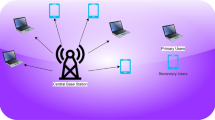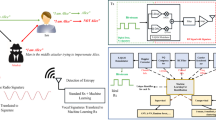Abstract
Spectrum allocation is a major challenge in wireless ad hoc networks due to restrictions on the number of available communication channels and also passive approaches to channel allocation in dealing with changes in the network environment, and it is impossible to achieve a perfect operational status, which includes a comprehensive communication. Adding cognition to current networks enables them to plan, learn, and reason, and also enables network nodes to self-adapt themselves to their surroundings and to adjust the required bandwidth to perform their operations. This paper introduces a cognitive ad hoc network with two cognitive elements with the aim of improving the use of wireless spectrum. These elements are placed at each node of the network. One element predicts the traffic at each node using neural networks, and the other solves the problem of channel allocation according to this predicted traffic using a non-cooperative game of learning automata and the techniques for allocating variable-width channels. Then, an analysis is done on the convergence of the algorithm and achieving the Nash equilibrium in the game. The purposes of the proposed algorithm are efficient spectrum use, reducing interference, and achieving the ultimate goals of the network, which are quality of service parameters such as high throughput and low latency. Simulation results showed the superior performance of the proposed algorithm compared to alternative approaches.















Similar content being viewed by others
References
Thomas, R. W., et al. (2007). Cognitive networks. Berlin: Springer.
Gheisari, S., & Meybodi, M. R. (2016). LA-CWSN: A learning automata-based cognitive wireless sensor networks. Computer Communications, 94, 46–56.
Friend, D. H. (2009). Cognitive networks: Foundations to applications. Ph.D. thesis, Electrical and Computer Engineering Department, Virginia Tech University, Blacksburg, Virginia.
Thomas, R. W., et al. (2006). Cognitive networks: Adaptation and learning to achieve end-to-end performance objectives. Communications Magazine, IEEE, 44(12), 51.
Meshkova, E., Riihijarvi, J., Achtzehn A., & Mahonen, P. (2009). Exploring simulated annealing and graphical models for optimization in cognitive wireless networks. In Global telecommunications conference, 2009. GLOBECOM 2009. IEEE (pp. 1–8). IEEE.
Shereef, K., & Baboo, S. S. (2011). A new weather forecasting technique using back propagation neural network with modified Levenberg–Marquardt algorithm for learning. IJCSI International Journal of Computer Science, 8(6), 1694.
Yuan, W., et al. (2009). Variable-width channel allocation in wireless LAN: A game-theoretic perspective. In IEEE international conference on communications, 2009. ICC’09. IEEE.
Yuan, W., et al. (2013). Variable-width channel allocation for access points: A game-theoretic perspective. IEEE Transactions on Mobile Computing, 12(7), 1428–1442.
Tan, K., et al. (2012). Detecting spectrum misuse in wireless networks. In 2012 IEEE 9th international conference on mobile adhoc and sensor systems (MASS). IEEE.
Chandra, R., et al. (2008). A case for adapting channel width in wireless networks. ACM SIGCOMM Computer Communication Review, 38(4), 135–146.
Li, L., & Zhang, C. (2009). Optimal channel width adaptation, logical topology design, and routing in wireless mesh networks. EURASIP Journal on Wireless Communications and Networking, 2009, 10.
Namboodiri, V., & Gao, L. (2010). Energy-efficient VoIP over wireless LANs. IEEE Transactions on Mobile Computing, 9(4), 566–581.
Chen, J., et al. (2012). SES: Stable and efficient solution for rate control and spectrum allocation in wireless LANs. Wireless Personal Communications, 66(1), 81–99.
Rayanchu, S., et al. (2012). FLUID: Improving throughputs in enterprise wireless lans through flexible channelization. IEEE Transactions on Mobile Computing, 11(9), 1455–1469.
Nam, C., Lee, J., & Bahk, S. (2010) Interference type based channel management using adaptive bandwidth in wireless LANs. In 2010 IEEE 21st international symposium on personal indoor and mobile radio communications (PIMRC). IEEE.
Chunguang, S., et al. (2013). Traffic-aware channelization medium access control for wireless ad hoc networks. Communications, China, 10(4), 88–100.
Akyildiz, I. F., Lee, W. -Y, & Chowdhury, K. R. (2009). CRAHNs: Cognitive radio ad hoc networks. Ad Hoc Networks, 7(5), 810–836.
Singh, J. S. P., & Rai, M. K. (2016). Cognitive radio intelligent-MAC (CR-i-MAC): Channel-diverse contention free approach for spectrum management. Telecommunication Systems, 64(3), 495–508.
Wang, W., et al. (2013). Sensing error aware delay-optimal channel allocation scheme for cognitive radio networks. Telecommunication Systems, 52(4), 1895–1904.
Chen, J., Gao, Y.-M., & Kuo, Y.-H. (2014). A parallel repeated auction for spectrum allocation in distributed cognitive radio networks. Wireless Personal Communications, 77(4), 2839–2855.
Friend, D. H., et al. (2008). Architecture and performance of an island genetic algorithm-based cognitive network. In 5th IEEE Consumer communications and networking conference, 2008. CCNC 2008. IEEE.
Thathachar, M., & Sastry, P. S. (2002). Varieties of learning automata: An overview. IEEE Transactions on Systems, Man, and Cybernetics, Part B: Cybernetics, 32(6), 711–722.
Narendra, K. S., & Thathachar, M. A. (2012). Learning automata: An introduction. Mineola: Courier Dover Publications.
Obaidat, M. S., et al. (2002). Learning automata-based bus arbitration for shared-medium ATM switches. IEEE Transactions on Systems, Man, and Cybernetics, Part B: Cybernetics, 32(6), 815–820.
Papadimitriou, G. I., Obaidat, M. S., & Pomportsis, A. S. (2002). On the use of learning automata in the control of broadcast networks: A methodology. IEEE Transactions on Systems, Man, and Cybernetics, Part B: Cybernetics, 32(6), 781–790.
Beigy, H., & Meybodi, M. R. (2009). Cellular learning automata based dynamic channel assignment algorithms. International Journal of Computational Intelligence and Applications, 8(03), 287–314.
Beigy, H., & Meybodi, M. R. (2006). Utilizing distributed learning automata to solve stochastic shortest path problems. International Journal of Uncertainty, Fuzziness and Knowledge-Based Systems, 14(05), 591–615.
Oommen, J., et al. (2007). Learning automata-based solutions to the nonlinear fractional knapsack problem with applications to optimal resource allocation. IEEE Transactions on Systems, Man and Cybernetics, 37, 166–175.
Beigy, H., & Meybodi, M. R. (2009). Adaptive limited fractional guard channel algorithms: A learning automata approach. International Journal of Uncertainty, Fuzziness and Knowledge-Based Systems, 17(06), 881–913.
Beigy, H., & Meybodi, M. R. (2009). A learning automata-based algorithm for determination of the number of hidden units for three-layer neural networks. International Journal of Systems Science, 40(1), 101–118.
Sastry, P., Nagendra, G., & Manwani, N. (2010). A team of continuous-action learning automata for noise-tolerant learning of half-spaces. IEEE Transactions on Systems, Man, and Cybernetics, Part B: Cybernetics, 40(1), 19–28.
Oommen, B. J., & Hashem, M. K. (2010). Modeling a student–classroom interaction in a tutorial-like system using learning automata. IEEE Transactions on Systems, Man, and Cybernetics, Part B: Cybernetics, 40(1), 29.
Eslamnour, B., Jagannathan, S., & Zawodniok, M. J. (2011). Dynamic channel allocation in wireless networks using adaptive learning automata. International Journal of Wireless Information Networks, 18(4), 295–308.
Lippmann, R. P. (1987). An introduction to computing with neural nets. ASSP Magazine, 4(2), 4–22.
Zhang, H.-C., & Huang, S. (1995). Applications of neural networks in manufacturing: A state-of-the-art survey. The International Journal of Production Research, 33(3), 705.
Mukherjee, I., & Routroy, S. (2012). Comparing the performance of neural networks developed by using Levenberg–Marquardt and Quasi-Newton with the gradient descent algorithm for modelling a multiple response grinding process. Expert Systems with Applications, 39(3), 2397–2407.
Thathachar, M. A., & Sastry, P. S. (2011). Networks of learning automata: Techniques for online stochastic optimization. New York: Springer.
Barbosa, A. V., Caetano, M. F., & Bordim, J. (2011). The theoretical maximum throughput calculation for the IEEE802. 11 g standard. International Journal of Computer Science and Network Security, 11(4), 136–143.
Jain, R., Chiu, D.-M., & Hawe, W. R. (1984). A quantitative measure of fairness and discrimination for resource allocation in shared computer system (Vol. 38). Hudson, MA: Eastern Research Laboratory, Digital Equipment Corporation.
Zhang, X. M., et al. (2015). Interference-based topology control algorithm for delay-constrained mobile ad hoc networks. IEEE Transactions on Mobile Computing, 14(4), 742–754.
Thathachar, M. A., & Sastry, P. S. (1986). Estimator algorithms for learning automata. Paper presented at the Proceedings of the Platinum Jubilee conference on systems and signal processing.
Author information
Authors and Affiliations
Corresponding author
Additional information
Publisher's Note
Springer Nature remains neutral with regard to jurisdictional claims in published maps and institutional affiliations.
Rights and permissions
About this article
Cite this article
Rahmani, P., Haj Seyyed Javadi, H., Bakhshi, H. et al. Cog-MAC Protocol: Channel Allocation in Cognitive Ad Hoc Networks Based on the Game of Learning Automata. Wireless Pers Commun 103, 2285–2316 (2018). https://doi.org/10.1007/s11277-018-5911-2
Published:
Issue Date:
DOI: https://doi.org/10.1007/s11277-018-5911-2




